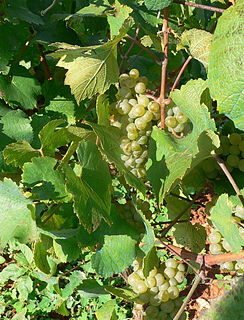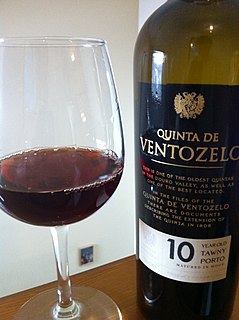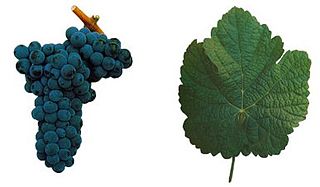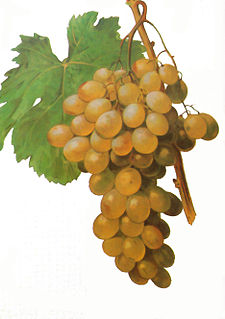
Malvasia is a group of wine grape varieties grown historically in the Mediterranean region, Balearic Islands, Canary Islands and the island of Madeira, but now grown in many of the winemaking regions of the world. In the past, the names Malvasia, Malvazia, and Malmsey have been used interchangeably for Malvasia-based wines; however, in modern oenology, "Malmsey" is now used almost exclusively for a sweet variety of Madeira wine made from the Malvasia grape. Grape varieties in this family include Malvasia bianca, Malvasia di Schierano, Malvasia negra, Malvasia nera, Malvasia nera di Brindisi, Malvasia di Candia aromatica, Malvasia odorosissima, and a number of other varieties.

Port wine is a Portuguese fortified wine produced in the Douro Valley of northern Portugal. It is typically a sweet red wine, often served as a dessert wine, although it also comes in dry, semi-dry, and white varieties.

Tempranillo is a black grape variety widely grown to make full-bodied red wines in its native Spain. Its name is the diminutive of the Spanish temprano ("early"), a reference to the fact that it ripens several weeks earlier than most Spanish red grapes. Tempranillo has been grown on the Iberian Peninsula since the time of Phoenician settlements. It is the main grape used in Rioja, and is often referred to as Spain's noble grape. The grape has been planted throughout the globe's wine regions.
Alvarelhão is a red wine grape grown in northern Portugal.

Verdelho is a white wine grape grown throughout Portugal, though most associated with the island of Madeira, and also gives its name to one of the four main types of Madeira wine. At the turn of the 20th century it was the most widely planted white grape in Madeira.

Touriga Nacional is a variety of red wine grape, considered by many to be Portugal's finest. Despite the low yields from its small grapes, it plays a big part in the blends used for ports, and is increasingly being used for table wine in the Douro and Dão. Touriga Nacional provides structure and body to wine, with high tannins and concentrated flavors of black fruit. Jancis Robinson has compared its relationship with Touriga Francesa to the partnership between Cabernet Sauvignon and Cabernet Franc, the former providing structure, the latter filling out the bouquet.

Portuguese wine is the result of traditions introduced to the region by ancient civilizations, such as the Phoenicians, Carthaginians, Greeks, and mostly the Romans. Portugal started to export its wines to Rome during the Roman Empire. Modern exports developed with trade to England after the Methuen Treaty in 1703. From this commerce a wide variety of wines started to be grown in Portugal. And, in 1758, one of the first wine-producing regions of the world, the Região Demarcada do Douro was created under the orientation of Marquis of Pombal, in the Douro Valley. Portugal has two wine-producing regions protected by UNESCO as World Heritage: the Douro Valley Wine Region and Pico Island Wine Region. Portugal has a big variety of local kinds, producing a very wide variety of different wines with distinctive personality.

Douro is a Portuguese wine region centered on the Douro River in the Trás-os-Montes e Alto Douro region. It is sometimes referred to as the Alto Douro, as it is located some distance upstream from Porto, sheltered by mountain ranges from coastal influence. The region has Portugal's highest wine classification as a Denominação de Origem Controlada (DOC). While the region is associated primarily with Port wine production, the Douro produces just as much table wine as it does fortified wine. The non-fortified wines are typically referred to as "Douro wines".

Touriga Francesa is one of the major grape varieties used to produce port wine. Touriga Francesa is lighter and more perfumed than Touriga Nacional, adding finesse to the wine. Touriga Francesa has been described by Jancis Robinson as playing "Cabernet Franc to Touriga Nacional’s Cabernet Sauvignon". It is a cross of two other indigenous Portuguese wine grape varieties Mourisco tinto and Touriga Nacional. Touriga Francesa is quite similar to Touriga Nacional, needing harsh conditions to keep vigor down as it gets on the steep arid slopes of the Douro. It is usually trained low to the ground under one of the Royat systems. Yields are medium (1,5 kg/vine), not as bad as Touriga Nacional.
South African wine has a history dating back to 1659, with the first bottle produced in Cape Town by its founder Jan van Riebeeck. Access to international markets led to new investment in the South African wine market. Production is concentrated around Cape Town, with major vineyard and production centres at Constantia, Paarl, Stellenbosch and Worcester. There are about 60 appellations within the Wine of Origin (WO) system, which was implemented in 1973 with a hierarchy of designated production regions, districts and wards. WO wines must only contain grapes from the specific area of origin. "Single vineyard" wines must come from a defined area of less than 5 hectares. An "Estate Wine" can come from adjacent farms if they are farmed together and wine is produced on site. A ward is an area with a distinctive soil type or climate and is roughly equivalent to a European appellation.

Muscat of Alexandria is a white wine grape that is a member of the Muscat family of Vitis vinifera. It is considered an "ancient vine", and wine experts believe it is one of the oldest genetically unmodified vines still in existence. The grape originated in North Africa, and the name is probably derived from its association with Ancient Egyptians who used the grape for wine making. It is also a table grape used for eating and raisins.

Tinta Cão is a red Portuguese wine grape variety that has been grown primarily in the Douro region since the sixteenth century. The vine produces very low yields which has led it close to extinction despite the high quality of wine that it can produce. Improvements in bilateral cordon training and experiments at University of California, Davis have helped to sustain the variety. The vine favors cooler climates and can add finesse and complexity to a wine blend.

Sezão, formerly known as Souzão, is a Portuguese wine grape that is used in the production of port wine and table wines.

Galician wine is Spanish wine made in the autonomous community of Galicia in the northwest corner of Spain. It includes wine made in the provinces of A Coruña, Ourense, Pontevedra and Lugo. Within Galicia are five Denominacións de Orixe (DO): Monterrei, Rías Baixas, Ribeira Sacra, Ribeiro and Valdeorras. In recent years, the region has seen a resurgence in its wine industry led by the international acclaim being received by the Rías Baixas region for its Albariño wines.

Carcavelos is a Portuguese wine region centered on the Carcavelos municipality in Estremadura region and includes land near the cities of Cascais and Oeiras. The region has Portugal's highest wine classification as a Denominação de Origem Controlada (DOC). Located at the very southern tip of the Estremadura region, the region has a long winemaking history dating back to the 18th century when Sebastião José de Carvalho e Melo, Marquis of Pombal owned vineyards here. The region is known for its fortified wine production, creating off dry, topaz colored wines that have nutty aromas and flavors. While once a thriving wine region, world-renowned in the 19th century for its tawny colored fortified wine, in the modern era Carcavelos has been devastated by real estate development in the suburbs of the capital city of Lisbon and nearby coastal city of Estoril.

Tinta Amarela or Trincadeira is a red wine grape that is commonly used in Port wine production. The grape is noted for its dark coloring. Its use in the Douro region has been increasing in recent years. The vine is susceptible to rot and performs better in dry, hot climates.

The Douro Wine Company was a government oversight organization established by the Portuguese Prime Minister Sebastião José de Carvalho e Melo, Marquis of Pombal to regulate the trade and production of Port wine. Established in 1756, one of the first official duties of the company was the delineation of the boundaries of the Douro wine region. This act essentially made the Douro the world's first regional appellation. While the boundaries of the Chianti and Tokaji wine regions were outlined in 1716 and 1737, respectively, neither of these regions were "technically" appellations in the sense of being subjected to continued government control and regulations. Under their charter, Pombal invested an immense amount of control in the Douro Wine Company to regulate all exports of Port, set production quantities limits, fix maximum and minimum prices for grapes and to serve as sole arbitrator in any disputes between vine growers and Port shippers. In 1761, the company was further granted a monopoly on the sale of brandy which was used in the fortification process of Port winemaking. The Douro Wine Company continued to operate to 1833. Today, many of it functions have been deregulated with the Instituto dos Vinhos do Douro e do Porto or being the official regulating body of Port wine and Douro table wine production.

The Quinta classification of Port vineyards in the Douro is a system that grades the terroir and quality potential of vineyards in the Douro wine region to produce grapes suitable for the production of Port wine. In Portuguese, a quinta is a wine producing estate, which can be a winery or a vineyard. While other wine classification systems may classify the winery, the Douro quinta classification is based upon the physical characteristics of the vineyard. The classification system is run by the Instituto dos Vinhos do Douro e Porto (IVDP) and shares some similarities to the classification of Champagne vineyards in that one of the purposes of the system is to ensuring that vineyards producing grapes with the highest quality potential receive a high price. A secondary function of the quinta classification is the establishment of permitted yields for production. Quintas with a higher classification are permitted to harvest more grapes than a vineyard that received a lower classification.

Duriense is a Portuguese wine region covering the same area as the Douro DOC and the Port wine region. In difference from Douro DOC, Duriense VR is a designation at the lower Vinho Regional (VR) level, which corresponds to table wines with a geographical indication under European Union wine regulations, similar to a French vin de pays region. Thus, it is the simpler or less typical wines of the Douro region that are sold using a Duriense VR label.
Donzelinho branco is a white Portuguese wine grape variety that is classified as one of the "Very Good" varieties authorized to be used in Port wine production. While rarely seen as a varietal wine, Donzelinho branco is a permitted variety in the white blends of several northern Portuguese wine regions including the Denominação de Origem Controlada (DOC) of Douro and Trás-os-Montes and the Vinho Regional (VR) wines of Duriense and Transmontano.

















